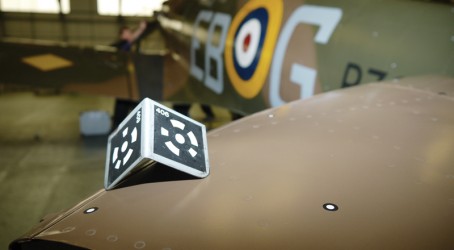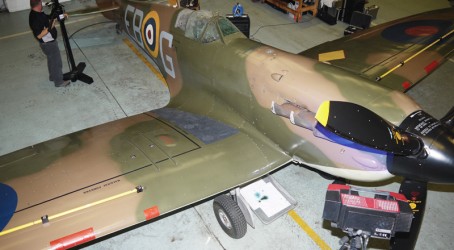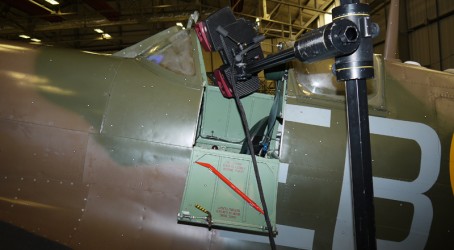A military base in Lincolnshire is home to a piece of aviation history that is being carefully preserved for future generations. RAF Coningsby houses the last airworthy Spitfire Mk IIa that flew sorties in the Battle of Britain during World War Two. And now engineers are making concerted efforts to ensure that the plane can continue to fly at air displays long into the future.
In recent weeks, Surrey-based Physical Digital has been using the latest optical technology including photogrammetry and touch-probe systems to scan the Spitfire in minute detail. The digital data will be archived to be used for reference if the aircraft is ever damaged and new parts need to be re-engineered. It will also be used to create a 1:16 scale model that is destined for the private collection of renowned architect Lord Foster.
Physical Digital’s managing director, Tim Rapley, is used to scanning valuable objects, having recently spent time digitising Formula One vehicles and classic cars within the personal collection of designer Ralph Lauren. But he says that working on something as iconic as the Spitfire project was particularly rewarding, while at the same time posing its own set of unique challenges. “It was a real honour to work on the Spitfire, which is an emotive piece of British engineering history.
“But the project was complex for a variety of reasons. Most importantly, the integrity of the aircraft had to be maintained, so moving it for scanning purposes wasn’t an option. Mobile 3D scanning instruments are the best option for large machines that need to be kept in controlled environments.
“In addition, the digitising was carried out in the storage and maintenance hangar at RAF Coningsby, which is fully operational with four squadrons of Eurofighter Typhoons. It was vital that the scanning procedures did not interfere with the day-to-day operation of the base. The topography of the Spitfire also required different types of scanning systems in order to produce the information needed for an exact scale model,” he says.
Most of the data capture was carried out using Tritop photogrammetry technology from optical measuring specialist Gom Systems. Tritop was used to take high-resolution 2D images of the plane to create an accurate 3D coordinate framework based on digital photogrammetry techniques.
Coded and uncoded markers were applied to and around the plane, along with internationally certified scale bars, then multiple photographs were taken from different angles. The software worked out precisely the 3D coordinates of the centre of the markers. These coordinates were then used as a reference framework for scanning.
Uncoded markers of 5mm diameter were used across the frame of the plane. Movable parts such as the cockpit, rudder, ailerons and elevators were captured in their extreme positions in order for the model to show the deflection angles of the control surfaces. The system allowed for high levels of accuracy, in this case <0.02mm/m3.
An Advanced Topometric Sensor system was also employed. This involved the use of a white-light optical scanner which scans 3D objects and converts the images into a high-density point cloud. The scanning is based on optical triangulation and stereo viewing. A projector is used to project a striped fringe pattern onto the object’s surface. These images are captured simultaneously by cameras from different angles. 3D coordinates are captured fast to a high accuracy; this is repeated for up to seven million points per scan.


The captured scan is then automatically integrated into the Tritop framework; the sensor uses these markers to correctly align each scan. The markers are also used for self-calibration and verification, and can detect movement and lighting changes which would affect the accuracy.
But these two systems are not suited to scanning all types of materials, particularly those that emit reflections. So an optically tracked touch probe was used to digitise the Spitfire’s glass canopy. The handheld probe was used to determine the location of the complex bubble-shaped canopy glass. These points were turned into a mesh in the post-processing stage and added into the project.
Finally, specialised software was used to create CAD models from the scan data. This will allow new components and tools to be reverse-engineered, redesigned, optimised and manufactured with precision.
Now that the data has been captured and processed, the model makers will begin work on a project that will take several thousand hours to complete. An entire master set of components has to be modelled using a range of skills, including digital machining, traditional engineering and hand-crafting. Once the components are complete, they will be painted and finished in exactly the same way as the original aircraft would be, resulting in accurate colour, finish and polish detail. Then it will take another 300 hours to assemble the model. The finished model will come with a replica log book.
Rapley says that Physical Digital has several other exciting projects in the pipeline. “We’ve been exceptionally busy,” he says. “Recently we’ve been working with several automotive firms to scan clay models for new car development, and we have been carrying out inspections of body-in-white.
“We have also recently completed the scanning of a ground-station satellite dish. And then in January next year we travel to the United States to do more work on Ralph Lauren’s classic car collection. It’s a varied job, for sure.”

Battle scarred
P7350 is the oldest airworthy Spitfire in the world and the only Spitfire still flying today to have fought in the Battle of Britain. It is believed to be the 14th aircraft of 11,989 built at the Castle Bromwich “shadow” factory in Birmingham.
Entering service in August 1940, it flew in the Battle of Britain with 266 Squadron and 603 (City of Edinburgh) Auxiliary Air Force Squadron.
While serving with the latter at Hornchurch in Essex, on or about 25 October 1940 the plane was involved in combat with Bf 109s and forced to crash land. It was quickly repaired at No 1 Civilian Repair Unit, Cowley, and flew again on 15 November. Repaired bullet holes can still be seen on the port wing.
Subsequently the Spitfire served operationally with 616 and 64 Squadrons. After April 1942 it was relegated to support duties with the Central Gunnery School and 57 OTU and ended its operational career with No 19 Maintenance Unit at RAF St Athan.
During the war, “P7” suffered three “cat B” flying accidents, at Tangmere, Hornchurch and Sutton Bridge.